Scottish Greenhouse Gas Emissions 2013
This publication provides estimates of greenhouse gas emissions in Scotland for the years 1990 to 2013.
This document is part of a collection
Section C. Estimated Emissions Adjusted for Trading Within the EU Emissions Trading System (EU ETS)
What is the EU Emissions Trading System (EU ETS)?
Launched in 2005, the EU ETS is an EU policy aimed at mitigating climate change by limiting greenhouse gas emissions from industry sectors and aviation. Participants include more than 11,000 heavy energy-using installations in power generation, the manufacturing industry and airlines across 31 countries in the European Economic Area (EEA).
How does it work?
The EU ETS is a 'cap and trade' system. A limit (cap) is placed on the overall volume of emissions from participants in the system. Within the cap, organisations receive or buy emissions allowances which they can trade (1 emissions allowance equals 1 tCO2e). Each year, an organisation must surrender enough allowances to cover its emissions. The cap is reduced over time so that by 2020, the volume of emissions permitted within the system will be 21% lower than in 2005. The reducing cap, alongside the financial considerations of trading emissions allowances, incentivises organisations within the system to find the most cost effective way of reducing their emissions. The EU ETS operates as a number of Phases. Phase III of the EU ETS began on 1 January 2013 and will operate until 31 December 2020.
Scotland in the EU ETS
The EU ETS contributes to delivering Scotland's Climate Change Targets through incentivising the reduction in emissions from Scottish organisations participating in the system. In 2013, there were 79 fixed Scottish installations which are regulated by Scottish Environment Protection Agency (SEPA) that surrendered emissions allowances in the EU ETS.
What are 'traded emissions' and 'non-traded emissions'?
In the greenhouse gas inventory, source emissions can be categorised into traded and non-traded. Traded emissions capture those that come from installations covered by the EU ETS, whereas Non-traded emissions are those which do not fall within the scope of the EU ETS. The emissions from some sectors, such as the residential sector, are completely non-traded whereas emissions from other sectors, such as energy supply and business and industrial process are a combination of traded and non-traded. For 2012 and 2013, CO2 emissions from domestic and international aviation are classified as being within the traded sector.
Chart C1. Estimate of Traded Emissions Surrendered in the EU Emissions Trading System (EU ETS) and Non-Traded Greenhouse Gas Emissions by Scottish Government Sector, 2013. Values in MtCO2e
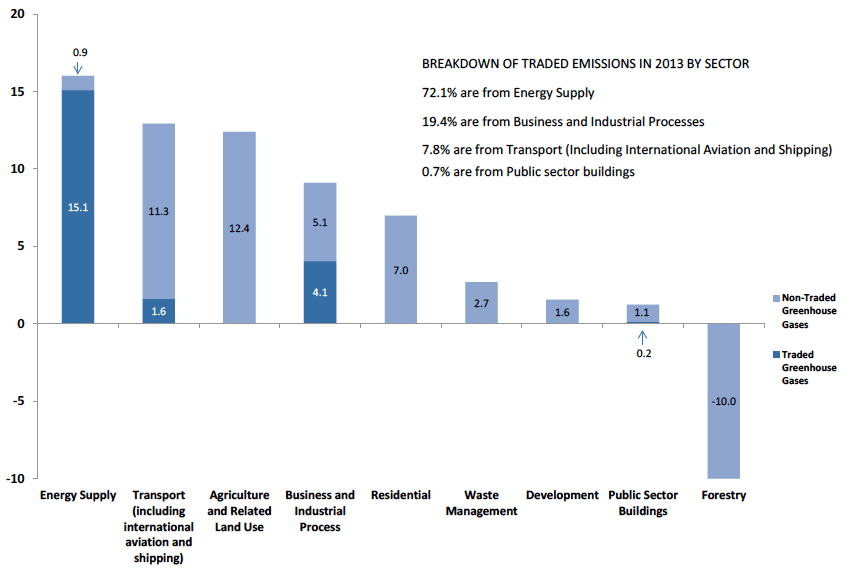
Note that the Scotland figure for the emissions which have been surrendered in the EU ETS is slightly different to that reported for traded emissions in the Greenhouse Gas Inventories for England, Scotland, Wales and Northern Ireland: 1990-2013 report produced by Ricardo-AEA on behalf of the devolved administrations.
There are number of reasons for this:
Firstly, the estimate of surrendered emissions include an estimate of carbon dioxide emissions surrendered from domestic and international aviation. Unlike for fixed installations, it is not possible to accurately estimate Scottish emissions which have been surrendered from aviation directly from aviation operators. Instead, the Scottish Government has received advice from the Committee on Climate Change to estimate the aviation emissions surrendered in the EU ETS by using figures taken directly from the 1990-2013 greenhouse gas inventory.
Secondly, operators who participate in the EU ETS must, by 30 April in each year, surrender a number of allowances in the registry equal to the annual reportable emissions which the installation made in the previous year. However, as a result of errors or non-compliance in the EU ETS, the figure on surrendered and reported emissions can differ, until both are rectified. These can be on-going situations throughout each Phase of the EU ETS. By the end of each Phase any difference between the two figures should be rectified.
What are adjusted emissions and the Net Scottish Emissions Account (NSEA)?
The Scottish climate change targets are assessed against the Net Scottish Emissions Account (NSEA), which is detailed in the Climate Change (Scotland) Act 2009 and has been reported for the years 2010, 2011, 2012 and 2013 as part of the Act. The NSEA accounts for the greenhouse gas emissions from sources in Scotland, Scotland's share of emissions from international aviation and international shipping, the effect of any relevant emissions removals (e.g. "carbon sinks" such as woodland) and the effect of the sale and purchase of relevant carbon units (tradable emissions allowances) in the EU ETS.
The EU ETS element of the NSEA is calculated by taking the difference between Scotland's notional share of the overall EU ETS cap and the number of emissions allowances surrendered from Scottish fixed installations in a given year, as well as an estimate of CO2 emissions surrendered from Scotland's share of domestic and international aviation. This amount is then added to non-traded net emissions to get the NSEA.
The NSEA formula is as follows:

For 2013, the figure for the NSEA are known as adjusted emissions, as they are adjusted to take account of trading within the EU ETS. This adjustment takes the form of a 4-step process, which is outlined in Chart C2.
Chart C2. Calculation of Adjusted Emissions for Trading in the EU Emissions Trading System (EU ETS), 2013. Values in MtCO2e
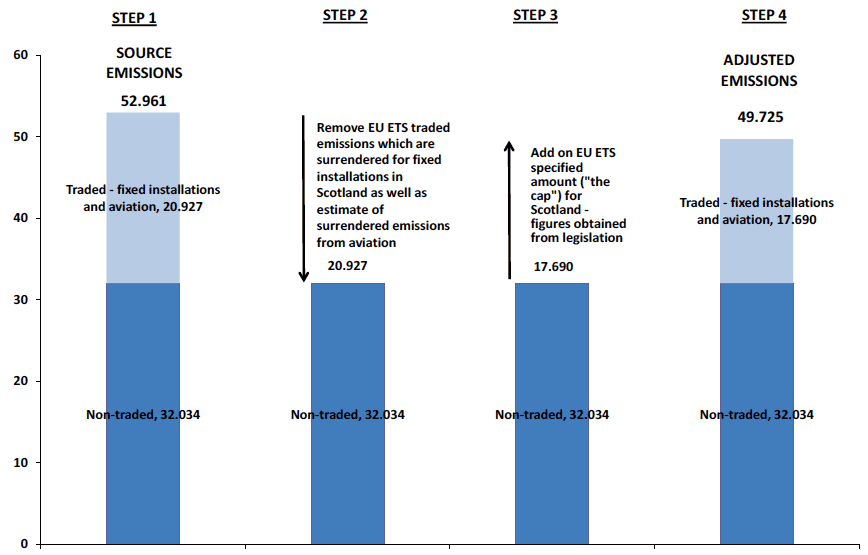
Calculation of adjusted emissions
STEP 1
Take the Scottish greenhouse gas emissions from Scottish greenhouse gas inventory (for 2013, it is 52.961 MtCO2e). This figure has been comprised of:
- traded emissions units surrendered - sourced from Scottish Environment Protection Agency (SEPA) for fixed installations (19.296 MtCO2e)
- an imputed estimate of surrendered CO2 emissions from domestic aviation (0.516 MtCO2e) and international aviation (1.115 MtCO2e) - sourced from the Scottish Greenhouse Gas Inventory for 1990-2013
- non-traded emissions from sources such as residential emissions (32.034 MtCO2e)
STEP 2
Remove an amount relating to surrendered emissions from fixed installations and an estimate of surrendered emissions from domestic and international aviation. This amounts to 19.296 MtCO2e + 0.516 MtCO2e + 1.115 MtCO2e = 20.927 MtCO2e.
STEP 3
Add on the value of the EU ETS cap which is the outlined within The Carbon Accounting Scheme (Scotland) Amendment Regulations 2015[10]. The cap reflects an estimate of the Scottish share of the European wide EU ETS cap that is used for emissions accounting. For 2013, this cap was separated into 3 components, as shown in the table below.
Total EU ETS cap for Scotland, 2013
| Component | 2013 Allocation tCO2e |
|---|---|
| Fixed Installation Cap | 16,325,296 |
| Domestic Aviation Cap | 443,255 |
| International Aviation Cap | 921,758 |
| Total 2013 Cap | 17,690,309 |
The Scottish EU ETS cap for 2013 is therefore 17.690 MtCO2e. The Scottish Government has published a methodological paper titled Determining a Scottish EU ETS cap for 2013 , which documents the calculations that determine how a notional emissions cap has been calculated for (i) greenhouse gas emissions from fixed installations located in Scotland (ii) and Scotland's share of emissions from domestic and international aviation.
STEP 4
Adding on the value of the EU ETS cap gives a value of 49.725 MtCO2e.
In 2013, the adjusted emissions which take account of trading in the EU ETS is 49.725 MtCO2e. This is 3.236 MtCO2e lower than the value of estimated source emissions in 2013.
Scottish Climate Change Targets
Scotland has a number of targets for reducing greenhouse gas emissions contained in legislation, within the Climate Change (Scotland) Act 2009. These targets can be summarised as follows:
The Act creates a statutory framework for greenhouse gas emissions reductions in Scotland by setting an interim target of at least a 42 per cent reduction for 2020, and at least an 80 per cent reduction target for 2050. These reductions are based on a 1990 baseline (1995 for the F-Gases). The Act also requires that Scottish Ministers set fixed annual targets for emissions at least 12 years in advance.
In October 2010 the Scottish Parliament passed legislation setting the first batch of annual targets, for the years up to 2022[11]. Targets for 2023-2027 were set in October 2011[12], and will continue to be set at 5-year intervals.
The 2013 target is 47.976 MtCO2e.
Achievement of Scotland's targets is measured against the level of the Net Scottish Emissions Account (NSEA). There is a limit on the net amount of carbon units that may be credited to the NSEA in addition to those from the EU Emissions Trading System. The Climate Change (Limit on Carbon Units) (Scotland) Order 2010[13] specifies that the net amount of carbon units that may be credited to the Net Scottish Emissions Account for the period 2010-2012 is zero. The Climate Change (Limit on Carbon Units) (Scotland) Order 2011[14] sets limits for the period 2013-2017.
Chart C3 contains data from the latest (1990-2013) inventory, adjusted for trading in the EU Emissions Trading System as well as data on progress against the 42 per cent and 80 per cent reduction targets. These percentage targets are based on a percentage reduction from the Baseline Period in the latest inventory.
Chart C3. Percentage Reductions Targets - Based on Adjusted Emissions. Values in MtCO2e
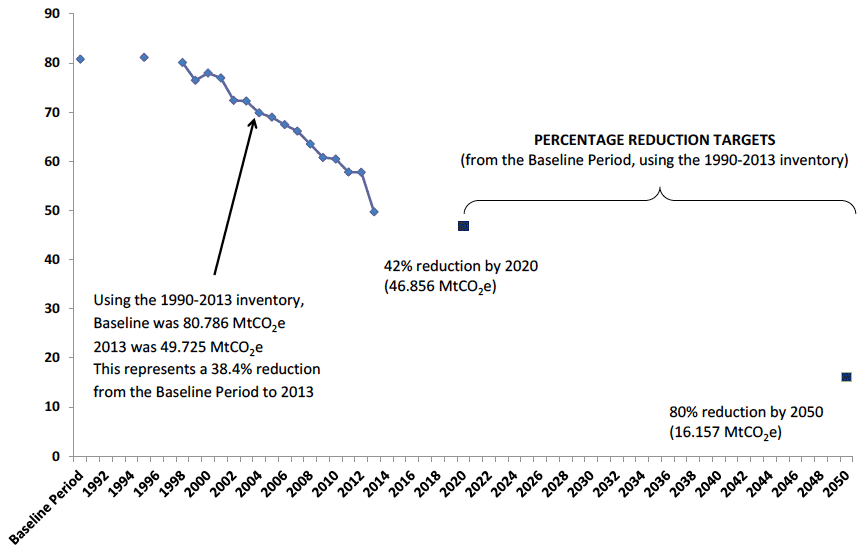
Chart C4 contains data from the latest (1990-2013) inventory, adjusted for trading in the EU Emissions Trading System. The fixed annual targets are also presented on this chart. The fixed annual targets were set at the time of the 1990-2008 inventory. Emissions adjusted for trading in the EU ETS using the 1990-2008 are shown for context.
Chart C4. Comparison of Adjusted Emissions and the Fixed Annual Targets which are based on the 1990-2008 Inventory. Values in MtCO2e
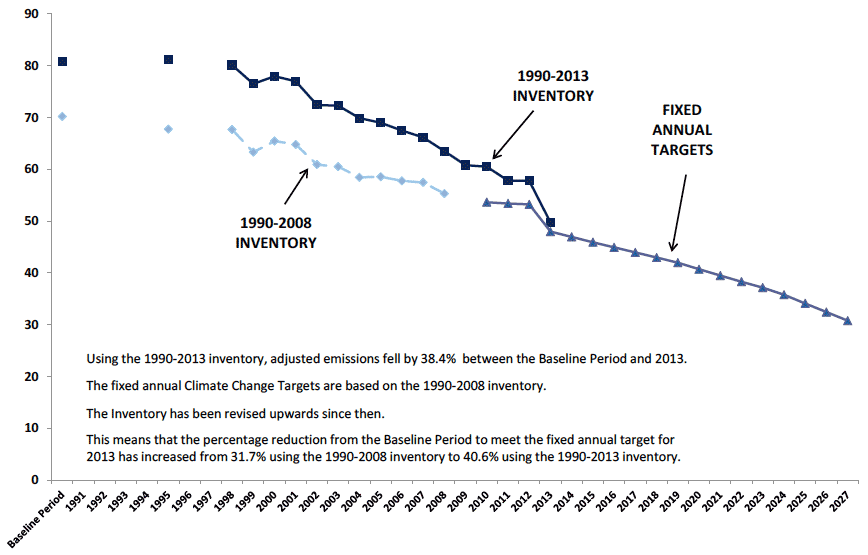
National performance framework sustainability purpose targets
In addition to the statutory Climate Change Targets, these statistics are used to monitor progress against the Scottish Government's Sustainability Purpose Targets
There are two targets:
- The long term target (2050) now equates to the target in the Climate Change (Scotland) Act 2009.
- The Scottish Government also set a short term target to reduce emissions by 2011 compared with a 2006 baseline.
Information on progress towards these targets can be found on the Scottish Government Scotland Performs website.
Effect of the adjustment to take into account of trading in the EU Emissions Trading System
Chart C5 demonstrates the effect of the adjustment for trading in the EU ETS, for calculation of the Net Scottish Emissions Account (NSEA).
Chart C5. Greenhouse Gas Emissions Adjusted for the Emissions Trading System (EU ETS). Values in MtCO2e
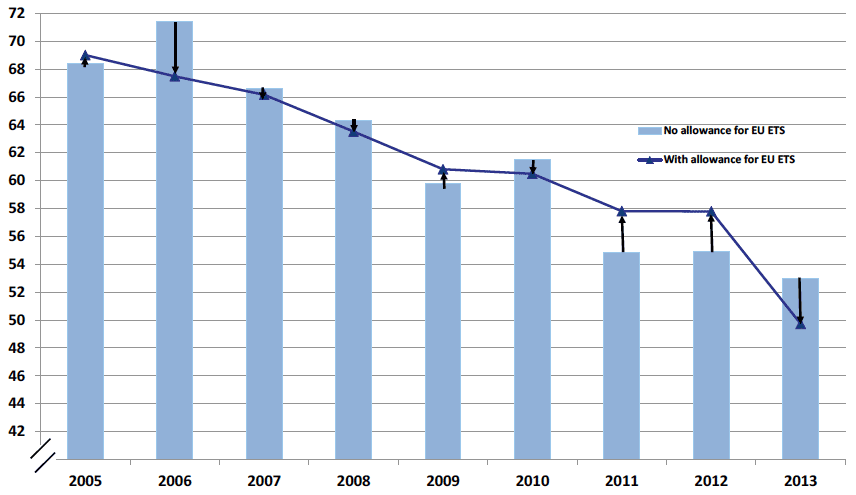
In four of the last 9 years, the adjustment has increased reported emissions, with 2011 and 2012 showing sizeable increases from the adjustment. In 2013, the adjustment has seen a sizeable (3.236 MtCO2e) decrease for the reported cap. This reflects Scotland's notional share of the EU ETS cap in 2013 and the tightening of the EU ETS cap between Phases II and III.
Table C1. Scottish greenhouse gas emissions adjusted to take account of trading in the EU Emissions Trading System. Baseline Period to 2013. Values in MtCO2e
| Baseline Period | 1995 | 1998 | 1999 | 2000 | 2001 | 2002 | 2003 | 2004 | 2005 | 2006 | 2007 | 2008 | 2009 | 2010 | 2011 | 2012 | 2013 | ||
|---|---|---|---|---|---|---|---|---|---|---|---|---|---|---|---|---|---|---|---|
| No allowance for EU ETS | Total Scottish greenhouse gas emissions (including international aviation and shipping) | 80.8 | 81.2 | 80.1 | 76.5 | 78.0 | 77.0 | 72.4 | 72.3 | 69.9 | 68.4 | 71.4 | 66.6 | 64.3 | 59.8 | 61.5 | 54.8 | 54.9 | 53.0 |
| Percentage change from Baseline Period | 0.5% | -0.8% | -5.3% | -3.5% | -4.7% | -10.3% | -10.5% | -13.5% | -15.3% | -11.6% | -17.5% | -20.4% | -26.0% | -23.9% | -32.1% | -32.0% | -34.4% | ||
| Differences between EU ETS cap and EU ETS surrendered emissions for Scotland | 0.6 | -4.0 | -0.5 | -0.8 | 1.0 | -1.0 | 3.0 | 2.9 | -3.2 | ||||||||||
| Scottish share of net purchases/(sales) by UK Government at the end of Phase I of EU ETS | 0.2 | 0.2 | 0.2 | ||||||||||||||||
| Scottish share of cancelled allowances by UK Government at the end of Phase II of EU ETS | -0.1 | -0.1 | -0.1 | -0.1 | -0.1 | ||||||||||||||
| Differences between EU ETS cap and traded emissions for Scotland - adjustment to emissions | 0.8 | -3.8 | -0.3 | -0.9 | 0.9 | -1.1 | 2.9 | 2.8 | -3.2 | ||||||||||
| With allowance for EU ETS | Total Scottish greenhouse gas emissions | 80.8 | 81.2 | 80.1 | 76.5 | 78.0 | 77.0 | 72.4 | 72.3 | 69.9 | 69.0 | 67.5 | 66.2 | 63.5 | 60.8 | 60.5 | 57.8 | 57.8 | 49.7 |
| Percentage change from Baseline Period | 0.5% | -0.8% | -5.3% | -3.5% | -4.7% | -10.3% | -10.5% | -13.5% | -14.6% | -16.5% | -18.1% | -21.4% | -24.7% | -25.1% | -28.4% | -28.5% | -38.4% |
Contact
Email: Martin Macfie
There is a problem
Thanks for your feedback